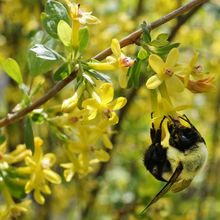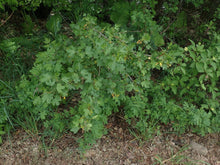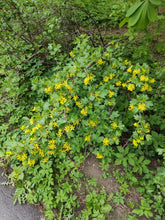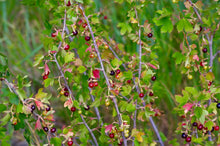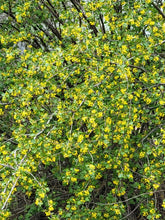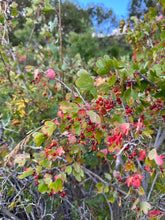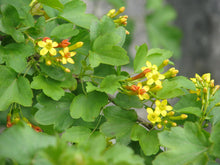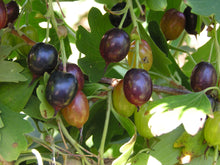
Ribes aureum
Golden currant is effortlessly gorgeous. This showy, upright shrub flaunts three seasons of beauty. Its deciduous leaves emerge bright green and glossy in spring and are soon followed by racemes of charming golden flowers that often have a faint spicy-fragrance like cloves or vanilla and are adored by hummingbirds, butterflies, bees and beneficial insects. In late summer, flowers mature into small berries that are amber yellow to black in color, edible (with ample sweetener added), and attract a wide range of birds. By fall, the leaves transition to hues of orange and red.
- Plant type/canopy layer: large, deciduous shrub
- Size at maturity: 6-10' tall, 5-10' wide
- Light requirements: full sun, part-sun/part-shade
- Moisture requirements: dry to wet soil
- Bloom time: April - June
- Growth rate/ease: moderate growth rate, easy to grow
- Wildlife support: flowers attract and support hummingbirds as well as adult bees and butterflies such as the spring azure and mourning cloak,; fruits attract and support many species of birds and small mammals; overall plant attracts and supports beneficial insects
- Native habitat/range: grows in moist woods and gravel streambanks and floodplains of ponderosa pine and sagebrush, east of the cascades in Washington, Oregon, Northern California and a small section of southern British Columbia. Portland Plant List - no.
- Special features & uses: hummingbird and wildlife magnet; pollinator favorite; exceptionally drought-tolerant; edible berries, though bitter and tart; medicinal; landscape uses include pollinators gardens, habitat hedgerows and privacy screens
Gardening with Golden Currant: Not only does it thrive in full sun to partial shade; dry, moist or wet soils - it also tolerates heavy, poorly-draining soils. Plus, even though its not locally/historically native to the Portland metro, it's proving to tolerate the erratic and extreme temperatures that climate change has in store for us than its red-flowering and locally-native cousin (Ribes sanguineum). Like nearly all native shrubs, be sure to water it deeply, but infrequently as it gets established. Once established, it will appreciate but doesn't require occasional (i.e. monthly) deep waterings.
Try intermixing it with evergreen species in habitat hedgerows and screens, or simply plant it as the statement piece in your sunny native meadowscape or pollinator garden surrounded by drought-tolerant groundcovers like alliums and camas.
Photo Credit 1 (with bumblebee): "Ribes aureum (Golden Currant)" by Plant Image Library is licensed under CC BY-SA 2.0.
Photo Credit 2 (at forest edge): © Mitch Van Dyke, some rights reserved (CC-BY)
Photo Credit 3 (flowering at forest edge): © Dmitrii Mostovoi, some rights reserved (CC-BY)
Photo Credit 4 (flowers/leaves, closeup): "Ribes aureum" by peganum is licensed under CC BY-SA 2.0.
Photo Credit 5 (million flowers): © Charles Swift, some rights reserved (CC-BY)
Photo Credit 6 (berries on branches): © Michelle, some rights reserved (CC-BY)
Photo Credit 7 (berries on branches 2): © Matt Berger, some rights reserved (CC-BY)
Photo Credit 8 (berries, closeup): "Ab plant 1315 (Ribes aureum)" by Andrey Butko is licensed under CC BY-SA 3.0.








